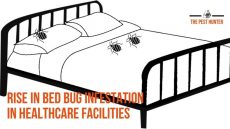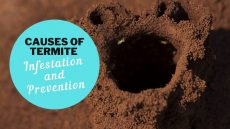It might be devastating to find that your furniture is losing its structural integrity and aesthetic value due to bugs. Different types of pests can bore into wood and make it a haven for themselves.
- Termites, carpenter ants, beetle bugs, powder post beetles, and bed bug fit this profile. These insects are generally called ‘the wood-boring beetle‘.
- These adult beetles usually lay their eggs in cracks and holes in the wood. When the eggs hatch, larvae, or woodworms are formed, eat their way out of the wood over several years.
- These insects wreak significant damage to wood furniture, floors, beams, eaves, and other structures around your home and property.
Usually, the beetle bore their way through the wood, weakening it and making it possible for structural failures.
Prevention is ultimately better than cure. You can save yourself and your furniture by inspecting your furniture before you take it into your home.
Heck, it might even be challenging to stay in the same environment as these insects. It is necessary to eliminate wood-boring insect from your home if you want to maintain the aesthetic value of your home.
The easiest method of avoiding bug infestation in the house is to ensure that you avoid bringing in infested wood, at times the insects are in the wood before it is made into the furniture, and then bore themselves out.
Getting rid of bugs
There are several do-it-yourself procedures you can take to get rid of pests. The only effective way to stop wood-boring insects from infesting your home is to make your wood an uncomfortable environment for them.
It is recommended that you confirm the type of beetle you are dealing with and whether the infestation is active to determine what kind of method would be most effective against the beetles. It is vital to resolve the problem correctly to avoid wasting time and money.
A few of these methods are discussed in this article;
1. Kill treatment
One effective way of handling wood-boring insects is to subject the wood to heat treatment in a kiln. The lumber is heated up to 150 degrees Fahrenheit in the kiln for several weeks, depending on the moisture content of the wood.
Subjecting the wood to this high temperature for this amount of time would kill the bugs in the wood. However, this procedure might cause wood shrinkage.
2. Freezing
Most wood-boring insects are incredibly vulnerable to low temperatures. Freezing the wood is a favorable option for being small pieces of furniture.
This sudden drop in temperature can quickly destroy the insects after roughly seven days. Before putting the furniture in the freezer, wrap it firmly with plastic.
After leaving it for a long time, usually, seven days, let the furniture remain wrapped while the temperature rises back to room temperature. It is done to stop watermarks from occurring.
3. Spreading under sunlight
The sunlight can be utilized to get rid of bugs. Most wood-boring insects are incredibly vulnerable to high temperatures. Wrap the wood item in a plastic bag and spread it under the sun. The resulting high temperature should be enough to kill bugs. The wood might be cut to bits with a wood splitter to increase the impacts of the sun.
4. Fumigation
Another convenient method of controlling these pests is fumigation. Fumigation is a foolproof method of dealing with pests by filling the area with pesticides that are poisonous to these bugs.
However, care should be taken when fumigating because these chemicals are harmful to humans as well. Cover the wood item with a plastic bag to prevent the chemicals from seeping into the environment. This would guarantee that the fumigant is directed straight into the wood.
This process can last hours or days, depending on the level of concentration of the fumigant. Make sure you handle the disposal of the remaining chemical properly. Wash your hands thoroughly after fumigation.
5. Chemical treatment of borax in water
The borax solution is an ideal family choice for dealing with this kind of menace. This is because it is entirely safe for both humans and pets but deadly for pests.
Prepare a mixture of borax solution by adding borax to water. All you need to do is wash your wood using a sponge with borax solution and allow it to absorb the moisture. Ensure the borax solution penetrates the holes in the wood. This should take care of any wood-boring insect present in the wood.
You might make use of a wood splitter to cut the wood into small bits to increase the area of contact with the borax solution. A significant advantage of borax solution is that it doesn’t affect the finish of the wood.
6. Pressure treatment
Pressure treatments are considered the best and most effective method to extend and preserve the wood life. Preservatives protect the wood from attack by wood-boring insects, like termites. Pressure treatment is an excellent choice for recycled woods that would be used in a new project.
However, pressure treatment is not safe to be used indoors because of the chemical residue that remains on the wood. It should not be used to make kitchen furniture or in places where food preparation may take place.
The finished product usually contains chemicals that can be dangerous to human health. When using a wood splitter to cut the wood, be careful not to inhale the fumes.
7. Call a professional
In cases where the bugs are too much for you to handle, you might need to contact a professional for pest control. Pest control professionals can utilize some high powered chemicals such as cypermethrin, cyfluthrin, and permethrin. However, the service of a professional pest control expert might be expensive.
8. Replace the wood
In some extreme cases, it might be more comfortable and cheaper to dispose of and replace the wood with freshly treated wood. Dispose of the wood by using a wood splitter to cut the logs of wood and burn it. This might be the best choice if the infested wood is in a cluster of several other planks of wood, and you want to prevent the wood-boring bugs from spreading to the non-infested wood.
Conclusion
Termites, carpenter ants, beetle bugs, powder post beetles can be destructive to your wood. The sad part is that before these insects are discovered, your wood might have been destroyed. These wood-boring bugs are capable of causing widespread damage to the structural beams and joints that support your home.
Pests may cause considerable confusion for homeowners, wood suppliers, manufacturers, builders, and even pest control companies. Care should be taken with your wooden household pieces of furniture. This would ensure that you don’t create a habitable environment for wood-boring insects.








